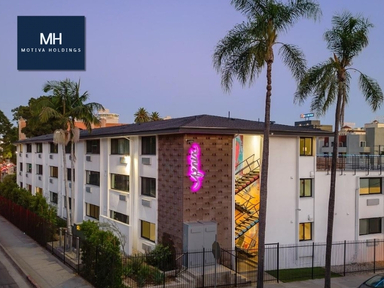Downey Plaza
Multifamily
Downey Plaza is a 90 unit multifamily value add project in Los Angeles, CA. The sponsor Motiva holdings is an exciting manager local to the market with $500M AUM, and a strong track record with recent exits averaging a 30% IRR.

Investing Simplified - Deal Summary
(See Key Terms tab above for explanations of words in bold & italics )
Downey Plaza is a 90-unit, off-market multifamily property in Downey, California—a submarket that has consistently avoided rent control measures. This offering is structured as an add-value syndication led by Zihao Wang, an emerging multifamily specialist managing over $500 million in assets with a history of successful exits. The sponsor originally acquired the property using personal equity, which underscores strong liquidity and financial capability, and is now “selling down” part of that position to bring in additional investors—often a strategic move to free up capital for other acquisitions or reinvest more in the project.
Unlike single-tenant investments, multifamily properties naturally spread risk across multiple residents, reducing the likelihood that all units will be vacant at once. This resilience is especially strong in high-demand urban areas like Greater Los Angeles, where there is always a steady need for housing. The sponsor plans to renovate both interiors and exteriors, aiming to raise below-market rents closer to competitive levels. Because this is an add-value strategy, any excess income during the 3- to 5-year hold is reinvested into property improvements, with distributions occurring primarily at the eventual sale.
Financing is structured at 65% loan-to-cost—slightly more conservative than typical multifamily deals—at a 6.75% fixed interest rate, helping shield the project from rate fluctuations. By focusing on a submarket with minimal rent control, along with a clear plan to enhance the asset, Downey Plaza presents an opportunity to capture both immediate rental upside and longer-term appreciation.
This syndication offers a 6% preferred return, and an 80/20 waterfall split all accrued to sale. This means at sale the first 6% of profits go directly to investors. While the remaining profits are split 80/20 between LP/GP. The sponsor projects 12-15% IRR returns at exit resulting in a 1.27x-1.38x multiple on invested capital.
Investing Simplified - Key Terms
Value-Add Strategy: A real estate investment approach focused on acquiring underperforming assets, making renovations, and optimizing operations to increase cash flow and asset value.
Syndication: A real estate syndication is when multiple investors pool their money to buy a property (or properties) together, sharing both the costs and the profits.
Loan-to-Cost (LTC) Ratio: Measures the proportion of total project costs financed by debt. A 65% LTC means 35% investor equity.
Exit Cap Rate: The anticipated capitalization rate at the time of sale.
Rent Control: Rent control is a set of laws that limit how much landlords can raise rent each year, aiming to keep housing more affordable for tenants. It’s typically enforced by local or state governments.
Strong Rental Upside
Current rents average $1,640 per unit, which is below the market average of $1,897, with projections indicating increases to $1,984 by Year 3. These figures suggest an excellent value-add opportunity.
Projected Exit
An anticipated exit cap rate of 5.50% aligns with current market trends and supports a profitable sale. Some sponsors inflate exit cap assumptions, but Motiva appears to use a more conservative and transparent approach, which benefits investors.
Efficient Operations Low Fees
Minimal sponsor fees and in-house property management favor investors, as the overall costs are covered through their investment contributions rather than additional markups.
Tax Benefits
Cost segregation provides tax advantages for investors who are mindful of efficiency and deductions, making the deal particularly appealing to those seeking tax-conscious strategies.
Well-Capitalized Sponsor
Motiva Holdings is backed by a family office and has already purchased the property, initiating renovations early and reducing investor capital lockup.
Unit Mix and Tenant Profile
All units are one-bedroom, one-bath, which primarily attract singles and young couples. This might limit significant rent increases over the long term, as the tenant base could be more sensitive to price changes.
Accruing Preferred Return
The 6% preferred return accumulates without immediate distributions, so investors will only realize gains upon the final exit or sale, rather than receiving ongoing cash flow.
LA Metro Market Risks
The post-pandemic era has seen a decline in the Los Angeles metro population, adding uncertainty to long-term demand for rental housing in the area.
Rent Growth vs. Tenant Affordability
Projected rents of $1,984 by Year 3 may stretch affordability for the target demographic, potentially affecting occupancy rates and overall performance if rents rise too quickly.
Debt Structure
A 6.75% fixed-rate loan, while stable, is not particularly competitive in today’s market, which could limit cash flow and may reduce overall returns compared to deals with more favorable lending terms.
This investment is suited for investors who are less focused on immediate cash flow and prefer to allocate capital to a proven, well-capitalized sponsor. It offers the tax depreciation benefits of multifamily housing and targets a standard return over a shorter, approximately three-year hold. The deal provides a stable, risk-adjusted opportunity with a sponsor that has exceeded prior projections. While it leans toward a safer profile, it may not offer the higher upside potential of more aggressive strategies.